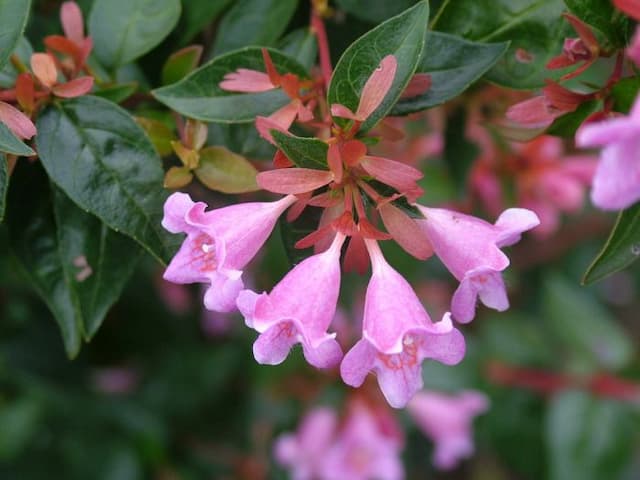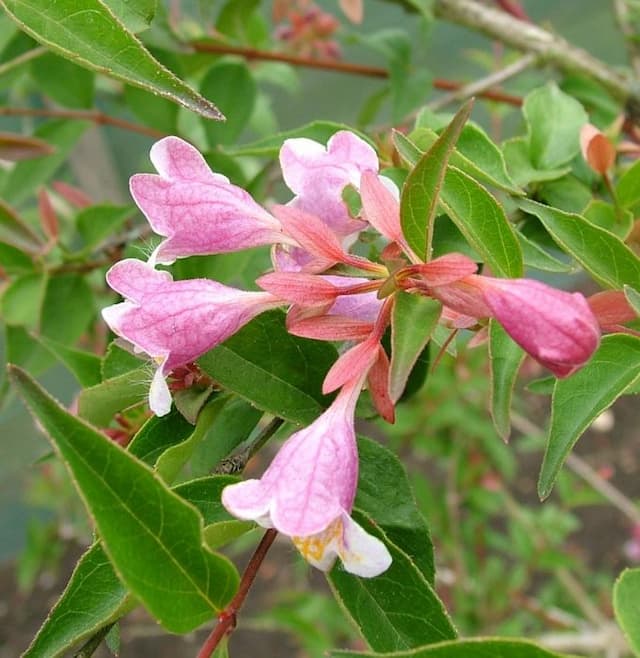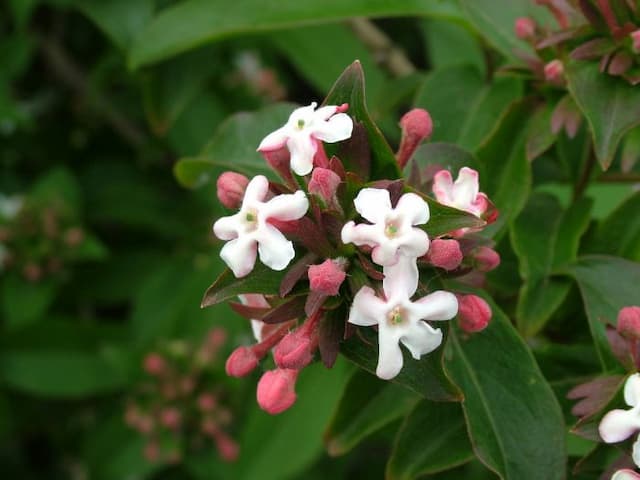Baggesen's Gold Honeysuckle Lonicera ligustrina var. yunnanensis 'Baggesen's Gold'

ABOUT
This plant, commonly known as 'Baggesen's Gold' Honeysuckle, is a vibrant and ornamental shrub with a striking appearance. It is characterized by its foliage, which is the most distinctive feature, offering a tapestry of colors throughout the seasons. The leaves are small and oval-shaped, presenting a rich golden-yellow hue with variations that can include hints of green, especially in the center. This coloration allows the shrub to stand out in garden settings, adding a splash of brightness. The 'Baggesen's Gold' Honeysuckle also produces delicate flowers that may be less noticeable against the boldness of the leaves but are attractive in their own right. These blooms are often creamy white, adding a soft contrast to the golden foliage. The flowers usually appear in the spring and may attract pollinators to the garden. Following the flowering period, small berries may develop. However, the berries are not as significant of a feature when it comes to the aesthetic appeal of this particular variety. Nonetheless, they can provide some additional interest later in the season. Throughout the different seasons, the foliage may transition in color intensity, but the golden tone is typically maintained, providing an enduring aesthetic impact. Even when not in flower or bearing fruit, the 'Baggesen's Gold' Honeysuckle remains an attractive plant primarily due to its foliage and overall form. It can serve as an excellent backdrop for other plants in a garden or can be used as a standalone feature for its colorful display.
About this plant
 Names
NamesFamily
Caprifoliaceae
Synonyms
Baggesen's Gold Honeysuckle, Baggesen's Gold Box Honeysuckle, Golden Boxleaf Honeysuckle
Common names
Lonicera nitida 'Baggesen's Gold', Lonicera ligustrina var. pileata 'Baggesen's Gold'
 Toxicity
ToxicityTo humans
Box Honeysuckle is generally considered to have a low level of toxicity to humans. However, ingestion of a significant amount of this plant might lead to mild digestive distress, including symptoms such as nausea, vomiting, and diarrhea. It is always advised to keep plants out of reach of young children who might accidentally ingest plant parts due to curiosity.
To pets
Box Honeysuckle could be toxic to pets if ingested. While this plant is not typically known for being highly poisonous, the consumption of leaves or berries may cause gastrointestinal upset in animals like dogs or cats. Symptoms can include vomiting, diarrhea, and abdominal pain. It is recommended to prevent pets from ingesting parts of this plant to avoid these potential consequences.
 Characteristics
CharacteristicsLife cycle
Perennials
Foliage type
Deciduous
Color of leaves
Gold
Height
5 feet (1.52 meters)
Spread
5 feet (1.52 meters)
Plant type
Shrub
Hardiness zones
5
Native area
China
Benefits
 General Benefits
General Benefits- Aesthetic Appeal: Adds vibrant golden-yellow foliage to the landscape.
- Versatility: Can be used in various settings such as hedges, foundation plantings, and borders.
- Growth Habit: Features a dense, bushy growth habit which provides structure and formality to garden designs.
- Wildlife Attraction: Flowers may attract pollinators such as bees and butterflies.
- Drought Tolerance: Once established, it can tolerate periods of low water availability.
- Shade Tolerance: Can grow in a variety of light conditions, including partial shade.
- Low Maintenance: Requires minimal care once established, with infrequent need for pruning.
- Seasonal Interest: Provides year-round interest due to evergreen foliage in regions with mild winters.
- Soil Adaptable: Thrives in a wide range of soil types, as long it's well-draining.
- Privacy Screen: Effective for creating a natural privacy screen or windbreak.
 Medical Properties
Medical PropertiesThis plant is not used for medical purposes.
 Air-purifying Qualities
Air-purifying QualitiesThis plant is not specifically known for air purifying qualities.
 Other Uses
Other Uses- Photography Prop: The Lonicera can be utilized by photographers as a vibrant backdrop or an element within natural scene compositions due to its colorful foliage.
- Insect Habitat: By providing shelter and potential nectar sources, the plant's dense growth habit can create a microhabitat for beneficial insects.
- Creative Crafts: Branches and leaves of the 'Baggesen's Gold' can be used in floral arrangements or to craft natural wreaths and other decorative items.
- Educational Tool: This plant can be incorporated into school gardens or educational programs to help teach children about plant growth and horticulture.
- Fragrance Source: While not commonly known for its fragrance, some people may use the flowers in potpourri or sachets.
- Natural Dye: The leaves and stems could potentially be used to derive natural dyes for textiles, though experimentation and extraction techniques would vary.
- Sensory Garden Component: Due to its textured leaves and visual appeal, it can be used in sensory gardens designed for therapeutic and educational purposes.
- Erosion Control: The dense root system of this shrub can help stabilize soil in slopes or areas prone to erosion.
- Privacy Screen: When planted in rows or clusters, 'Baggesen's Gold' serves as an aesthetically pleasing privacy screen or natural fence.
- Living Sculptures: Trained and pruned effectively, this Lonicera variety can be shaped into topiary forms to create living sculptures in gardens and parks.
Interesting Facts
 Feng Shui
Feng ShuiThe Box Honeysuckle ‘Baggesen’s Gold’ is not used in Feng Shui practice.
 Zodiac Sign Compitability
Zodiac Sign CompitabilityThe Box Honeysuckle ‘Baggesen’s Gold’ is not used in astrology practice.
 Plant Symbolism
Plant Symbolism- Love and Affection: The plant's genus, Lonicera, is commonly known as honeysuckle, which is often associated with love and the bonds of affection. This symbolism could extend to the 'Baggesen's Gold' cultivar, illustrating an intertwining relationship and the affectionate embrace between loved ones.
- Happiness and Cheerfulness: The bright yellow foliage of 'Baggesen’s Gold' exudes a sense of cheerfulness and positivity, often symbolizing happiness and the warmth of sunshine in the garden, potentially lifting spirits and spreading joy.
- Devotion: Honeysuckles are known to climb and support themselves on structures or other plants. This can symbolize devotion and support in relationships, suggesting a commitment to stick together and support each other through life.
- Generosity: With its lush growth and tendency to spread, 'Baggesen’s Gold’ may symbolize generosity and abundance, as it generously fills the space it grows in and shares its vibrant color and life with the surrounding environment.
- Protection: Historically, some cultures have believed that honeysuckle has protective qualities. 'Baggesen's Gold' could symbolize safeguarding and care, offering a sanctuary of sorts within its golden foliage.
 Water
WaterThe Box Honeysuckle 'Baggesen's Gold' prefers consistently moist soil, but it's important to avoid overwatering. Water the plant deeply when the top inch of soil feels dry to the touch, which typically means watering once or twice a week depending on weather conditions and soil drainage. A good method is to water at the base of the plant, avoiding wetting the foliage to minimize the risk of disease. An approximate amount would be 1-2 gallons for smaller shrubs, increasing the amount for larger specimens, ensuring the water penetrates to the root zone each time. Adjust watering frequency and volume according to rainfall and temperature changes, as the plant will need less water in cooler months and more in hot, dry periods.
 Light
LightThe Box Honeysuckle 'Baggesen's Gold' thrives best in full sun to partial shade. Ideally, it should be planted in a spot where it receives at least four to six hours of sunlight daily. However, in areas with very hot summers, some afternoon shade can help prevent leaf scorch.
 Temperature
TemperatureThe Box Honeysuckle 'Baggesen's Gold' can tolerate a range of temperatures and is hardy from USDA zones 6 through 9. It can survive temperatures as low as -10°F and as high as 100°F, but the ideal temperature range for vigorous growth is between 60°F and 80°F.
 Pruning
PruningPrune Box Honeysuckle 'Baggesen's Gold' to maintain its shape and promote bushier growth, removing dead or damaged branches whenever they are noticed. The best time for heavy pruning is late winter or early spring before new growth begins. Prune selectively rather than shearing to preserve the natural shape, and aim to prune no more than one-third of the plant in a single season for optimal health.
 Cleaning
CleaningAs needed
 Soil
SoilBoxleaf Honeysuckle requires well-draining, fertile soil with a preferred pH range of 5.5 to 7.5. A mix of loam, peat, and sand in equal parts can create an ideal environment.
 Repotting
RepottingBoxleaf Honeysuckle should be repotted every 2-3 years during spring before the onset of new growth to prevent the root system from becoming pot-bound.
 Humidity & Misting
Humidity & MistingBoxleaf Honeysuckle thrives in moderate humidity levels; it is generally adaptable but does best with around 40-60% humidity.
 Suitable locations
Suitable locationsIndoor
Provide bright, indirect light and moist, well-draining soil.
Outdoor
Plant in partial shade, sheltered from strong winds.
Hardiness zone
5-9 USDA
 Life cycle
Life cycleLonicera ligustrina var. yunnanensis 'Baggesen's Gold', commonly known as Yunnan Gold-leaf Privet, begins its life cycle when the seeds germinate in spring, requiring a combination of warmth and moisture. The seedlings then grow into juvenile plants, developing their characteristic golden-yellow foliage and branching habit. As the plants mature, they enter the vegetative stage, where they focus on producing a dense mass of leaves and stems, typically achieving a shrub-like form. During late spring to early summer, the mature plants will bloom, producing fragrant white flowers that attract pollinators. Following pollination, the flowers develop into small, black berry-like fruits during the autumn, which are often dispersed by birds and other animals, facilitating the spread of the plant in suitable growing conditions. Once established, Yunnan Gold-leaf Privet can live for many years, with proper care, before eventually reaching the end of its life cycle.
 Propogation
PropogationPropogation time
Spring-Early Summer
Propogation: The most common method for propagating Boxleaf Honeysuckle, specifically Lonicera ligustrina var. yunnanensis 'Baggesen's Gold', is through semi-hardwood cuttings. This method typically takes place in late summer to early fall. Cuttings, which are roughly 4 to 6 inches long, are snipped just below a node, and lower leaves are removed. The cut end is then dipped in a rooting hormone to enhance root development before being placed in a well-draining potting mix. The cutting is kept moist and in a warm, bright environment without direct sunlight until roots have established, which usually takes a few weeks. Once rooted, the young plants can be hardened off by gradually adjusting them to outdoor conditions before being transplanted into their final position.








![Himalayan honeysuckle [Golden Lanterns]](/_next/image?url=https%3A%2F%2Fplants-admin.emdemapps.com%2Fimages%2Fplants%2F%2Fimages%2F604b55302cc87.png&w=640&q=75)
